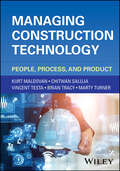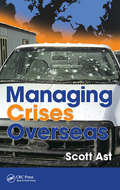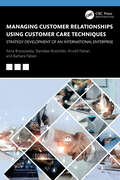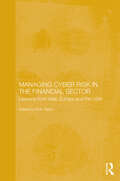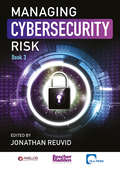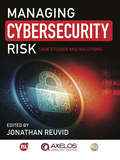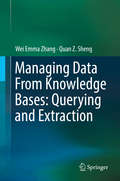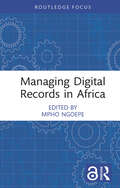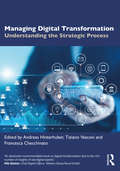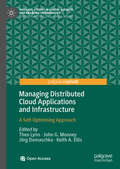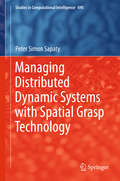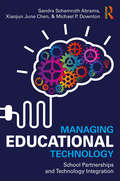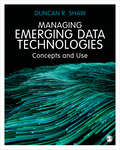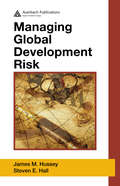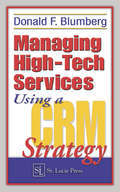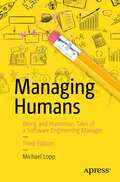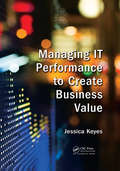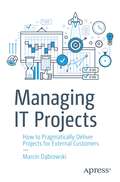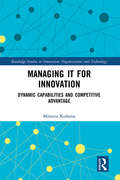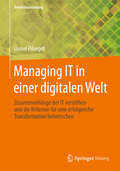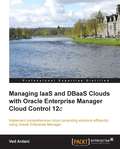- Table View
- List View
Managing Construction Technology: People, Process, and Product
by Brian Tracy Kurt Maldovan Chitwan Saluja Vincent Testa Marty TurnerMaximizes construction success with practical guidance on managing emerging technologies in the AEC industry In a rapidly evolving industry, effective management of construction technology is no longer optional — it is essential. Managing Construction Technology: People, Process, and Product delivers the insights and frameworks necessary to navigate the complex landscape of digital innovation in the architecture, engineering, and construction (AEC) fields. Emphasizing the need for a holistic approach that focuses on process improvements alongside technology deployment, the book guides readers through evaluating, implementing, and optimizing both existing and emerging technologies, including BIM, VDC, robotics, and AR/VR. Written by a team of experienced industry professionals, Managing Construction Technology offers actionable strategies to enhance efficiency, productivity, and sustained success. Step by step, the authors equip AEC stakeholders with tools to assess the cost-benefit balance of technology investments, craft systems for ongoing evaluation, and foster collaboration across project teams. Throughout the book, detailed management principles and diverse case studies help readers gain a comprehensive understanding of digital transformation tailored to various project types and organizational structures. Providing a detailed blueprint for embracing technological innovation, Managing Construction Technology Presents a proven methodology for evaluating and implementing cutting-edge technologies in the AEC industryIncludes real-world examples showcasing successful digital technology applications across diverse project types and scalesFeatures management principles designed to maximize ROI and streamline decision-making processes for technology investmentsAddresses critical topics such as cost-benefit analysis, stakeholder collaboration, and long-term infrastructure planningHighlights long-term developments and trends shaping the future of digital construction Managing Construction Technology: People, Process, and Product is ideal for advanced undergraduate and graduate students in construction technology, BIM, and digital project management within architecture, engineering, and construction management programs. It is also an invaluable reference for contractors, developers, architects, engineers, technology managers, and other professionals in the AEC industry.
Managing Crises Overseas
by Scott Alan AstThe book examines crisis management for operations located outside of a corporation’s normal confines, particularly in regions which might be overtly threatening or hostile to multinational corporations and their people and assets overseas. Outlining proper operating procedures, planning, implementation, and drills, it demonstrates how proper planning and effective management systems in place prior to a crisis can mean the difference between life and death. The book helps organizations establish best practices in crisis management to ensure safety and security of personnel, assets, and properties overseas, even in potentially volatile environments.
Managing Customer Relationships Using Customer Care Techniques: Strategy Development of an International Enterprise
by Anna Brzozowska Arnold Pabian Barbara Pabian Stanisław BrzezińskiIn today’s global business environment, Customer Relationship Management (CRM) has become key to the success of many international enterprises. Managing Customer Relationships Using Customer Care Techniques: Strategy Development of an International Enterprise offers a comprehensive analysis of this crucial business aspect, focusing on how companies can effectively manage their customer relationships in the context of global expansion. This book stands out with its unique approach to CRM, blending theory with practice and providing readers with a deep understanding of how CRM influences the strategies of international enterprises.The book is divided into four main parts, each focusing on a different aspect of customer relationship management. The first part focuses on creating strategies in the context of customer relationships in international enterprises, the second part discusses the essence of the CRM concept in companies, the third part delves into the strategy of a global enterprise from the customer relationship perspective, and the fourth part centers on the evaluation and optimization of customer care strategy in modern business.Key Features:• In-depth analysis of the CRM concept in the context of international business.• Discussion on the evolution of the CRM idea over the years.• Introduction to integrated customer relationship management systems in global enterprises.• Analysis of the impact of social media on CRM.• Practical insights on measuring the effectiveness of customer care activities.Managing Customer Relationships Using Customer Care Techniques: Strategy Development of an International Enterprise is a must-read for managers, business consultants, business students, and anyone wanting to understand how to effectively manage customer relationships in an international business environment.
Managing Cyber Attacks in International Law, Business, and Relations
by Jd Scott J. ShackelfordThis book presents a framework to reconceptualize internet governance and better manage cyber attacks. It examines the potential of polycentric regulation to increase accountability through bottom-up action. It also provides a synthesis of the current state of cybersecurity research, bringing features of cyber attacks to light and comparing and contrasting the threat to all relevant stakeholders. Throughout the book, cybersecurity is treated holistically, covering issues in law, science, economics and politics. This interdisciplinary approach is an exemplar of how strategies from different disciplines as well as the private and public sectors may cross-pollinate to enhance cybersecurity. Case studies and examples illustrate what is at stake and identify best practices. The book discusses technical issues of Internet governance and cybersecurity while presenting the material in an informal, straightforward manner. The book is designed to inform readers about the interplay of Internet governance and cybersecurity and the potential of polycentric regulation to help foster cyber peace.
Managing Cyber Risk in the Financial Sector: Lessons from Asia, Europe and the USA (Routledge Studies in the Growth Economies of Asia)
by Ruth TaplinCyber risk has become increasingly reported as a major problem for financial sector businesses. It takes many forms including fraud for purely monetary gain, hacking by people hostile to a company causing business interruption or damage to reputation, theft by criminals or malicious individuals of the very large amounts of customer information (“big data”) held by many companies, misuse including accidental misuse or lack of use of such data, loss of key intellectual property, and the theft of health and medical data which can have a profound effect on the insurance sector. This book assesses the major cyber risks to businesses and discusses how they can be managed and the risks reduced. It includes case studies of the situation in different financial sectors and countries in relation to East Asia, Europe and the United States. It takes an interdisciplinary approach assessing cyber risks and management solutions from an economic, management risk, legal, security intelligence, insurance, banking and cultural perspective.
Managing Cybersecurity Risk: Book 3
by Jonathan ReuvidCybersecurity is the practice of protecting systems, networks and programs from digital attacks. These attacks are usually aimed at accessing, changing or destroying sensitive information, extorting money from users or interrupting normal business processes.This new edition will provide valuable information on the cyber environment and threats that businesses may encounter. Such is the scale and variety of cyber threats, it is essential to recognise issues such as gaps in the workforce and the skills required to combat them. The guide also addresses the social and financial impacts of cyber breaches and the development of cyber protection for the future.Offering understanding and advice the book covers topics such as the following, all from key speakers and industry experts:TrainingTechnology trendsNew theoriesCurrent approachesTactical risk managementStories of human errors and their resultsManaging Cybersecurity Risk is an essential read for all businesses, whether large or small.With a Foreword by Don Randall, former head of Security and CISO, the Bank of England, contributors include Vijay Rathour, Grant Thornton and Digital Forensics Group, Nick Wilding, General Manager of Cyber Resilience at Axelos, IASME Consortium Ltd, CyberCare UK, DLA Piper, CYBERAWARE and more.
Managing Cybersecurity Risk: Cases Studies and Solutions
by Jonathan ReuvidThe first edition, published November 2016, was targeted at the directors and senior managers of SMEs and larger organisations that have not yet paid sufficient attention to cybersecurity and possibly did not appreciate the scale or severity of permanent risk to their businesses. <P><P> The book was an important wake-up call and primer and proved a significant success, including wide global reach and diverse additional use of the chapter content through media outlets. <P><P> The new edition, targeted at a similar readership, will provide more detailed information about the cybersecurity environment and specific threats. It will offer advice on the resources available to build defences and the selection of tools and managed services to achieve enhanced security at acceptable cost. A content sharing partnership has been agreed with major technology provider Alien Vault and the 2017 edition will be a larger book of approximately 250 pages.
Managing Data From Knowledge Bases: Querying and Extraction
by Quan Z. Sheng Wei Emma ZhangIn this book, the authors first address the research issues by providing a motivating scenario, followed by the exploration of the principles and techniques of the challenging topics. Then they solve the raised research issues by developing a series of methodologies. More specifically, the authors study the query optimization and tackle the query performance prediction for knowledge retrieval. They also handle unstructured data processing, data clustering for knowledge extraction. To optimize the queries issued through interfaces against knowledge bases, the authors propose a cache-based optimization layer between consumers and the querying interface to facilitate the querying and solve the latency issue. The cache depends on a novel learning method that considers the querying patterns from individual’s historical queries without having knowledge of the backing systems of the knowledge base. To predict the query performance for appropriate query scheduling, the authors examine the queries’ structural and syntactical features and apply multiple widely adopted prediction models. Their feature modelling approach eschews the knowledge requirement on both the querying languages and system. To extract knowledge from unstructured Web sources, the authors examine two kinds of Web sources containing unstructured data: the source code from Web repositories and the posts in programming question-answering communities. They use natural language processing techniques to pre-process the source codes and obtain the natural language elements. Then they apply traditional knowledge extraction techniques to extract knowledge. For the data from programming question-answering communities, the authors make the attempt towards building programming knowledge base by starting with paraphrase identification problems and develop novel features to accurately identify duplicate posts. For domain specific knowledge extraction, the authors propose to use clustering technique to separate knowledge into different groups. They focus on developing a new clustering algorithm that uses manifold constraint in the optimization task and achieves fast and accurate performance. For each model and approach presented in this dissertation, the authors have conducted extensive experiments to evaluate it using either public dataset or synthetic data they generated.
Managing Data Science: Effective strategies to manage data science projects and build a sustainable team
by Kirill DubovikovUnderstand data science concepts and methodologies to manage and deliver top-notch solutions for your organization Key Features Learn the basics of data science and explore its possibilities and limitations Manage data science projects and assemble teams effectively even in the most challenging situations Understand management principles and approaches for data science projects to streamline the innovation process Book Description Data science and machine learning can transform any organization and unlock new opportunities. However, employing the right management strategies is crucial to guide the solution from prototype to production. Traditional approaches often fail as they don't entirely meet the conditions and requirements necessary for current data science projects. In this book, you'll explore the right approach to data science project management, along with useful tips and best practices to guide you along the way. After understanding the practical applications of data science and artificial intelligence, you'll see how to incorporate them into your solutions. Next, you will go through the data science project life cycle, explore the common pitfalls encountered at each step, and learn how to avoid them. Any data science project requires a skilled team, and this book will offer the right advice for hiring and growing a data science team for your organization. Later, you'll be shown how to efficiently manage and improve your data science projects through the use of DevOps and ModelOps. By the end of this book, you will be well versed with various data science solutions and have gained practical insights into tackling the different challenges that you'll encounter on a daily basis. What you will learn Understand the underlying problems of building a strong data science pipeline Explore the different tools for building and deploying data science solutions Hire, grow, and sustain a data science team Manage data science projects through all stages, from prototype to production Learn how to use ModelOps to improve your data science pipelines Get up to speed with the model testing techniques used in both development and production stages Who this book is for This book is for data scientists, analysts, and program managers who want to use data science for business productivity by incorporating data science workflows efficiently. Some understanding of basic data science concepts will be useful to get the most out of this book.
Managing Data and Media in Silverlight 4: A mashup of chapters from Packt's bestselling Silverlight books
by Todd Snyder Gaston C. Hillar Gill Cleeren Joel Eden Kevin DockxDiscover content in various easy-to-follow styles such as a recipe based cookbook format, a turotial based beginner's guide, and a reference styled handbook. The aim of this book is to provide a lot of valuable content to you from various other Packt Silverlight books. It is designed in such a way that you can refer to topics chapter by chapter, and read them in no particular order. It offers clear examples to successfully perform the most important data related tasks in Silverlight. If you are a .NET developer who wants to manage professional data-driven applications with Sliverlight, then this book is for you. Basic experience of programming Silverlight and familiarity with accessing data using ADO.NET in normal .NET applications is required.
Managing Digital Records in Africa
by Mpho NgoepeManaging Digital Records in Africa draws on the research work of the InterPARES Trust (ITrust) project that investigated interrelated archival issues focusing on legal analysis, infrastructure, trust, authentication, and education within the African context. This research-focused book provides a legal analysis and systematic assessment of how African institutions manage digital records in four countries (i.e., Botswana, Kenya, South Africa, and Zimbabwe). It also examines the extent to which records are managed using Internet-based applications, trust in such records, and digital record authentication to support the auditing process. Finally, it provides a curriculum analysis in digital records at institutions of higher learning in 38 African countries. The book's case studies illustrate the threads of discussion, which span the ITrust domains of legislation, infrastructure, authentication, trust, and education in archives and records management. The book can be used as a premier reference source by private and public organizations, researchers, educators, archivists, records managers, and postgraduate students to make informed decisions about digital records, records management systems, cloud-based services, authenticating records, and identifying universities on the continent that offer archival programmes. The book may also find expression to practitioners in other fields such as law and auditing.
Managing Digital Transformation: Understanding the Strategic Process
by Andreas HinterhuberThis book provides practising executives and academics with the theories and best practices to plan and implement the digital transformation successfully. Key benefits: an overview on how leading companies plan and implement digital transformation interviews with chief executive officers and chief digital officers of leading companies – Bulgari, Deutsche Bahn, Henkel, Lanxess, L’Oréal, Unilever, Thales and others – explore lessons learnt and roadmaps to successful implementation research and case studies on the digitalization of small and medium-sized companies cutting-edge academic research on business models, organizational capabilities and performance implications of the digital transformation tools and insights into how to overcome internal resistance, build digital capabilities, align the organization, develop the ecosystem and create customer value to implement digital strategies that increase profits Managing Digital Transformation is unique in its approach, combining rigorous academic theory with practical insights and contributions from companies that are, according to leading academic thinkers, at the forefront of global best practice in the digital transformation. It is a recommended reading both for practitioners looking to implement digital strategies within their own organisations, as well as for academics and postgraduate students studying digital transformation, strategy and marketing.
Managing Distributed Cloud Applications and Infrastructure: A Self-Optimising Approach (Palgrave Studies in Digital Business & Enabling Technologies)
by Theo Lynn John G. Mooney Jörg Domaschka Keith A. EllisThe emergence of the Internet of Things (IoT), combined with greater heterogeneity not only online in cloud computing architectures but across the cloud-to-edge continuum, is introducing new challenges for managing applications and infrastructure across this continuum. The scale and complexity is simply so complex that it is no longer realistic for IT teams to manually foresee the potential issues and manage the dynamism and dependencies across an increasing inter-dependent chain of service provision. This Open Access Pivot explores these challenges and offers a solution for the intelligent and reliable management of physical infrastructure and the optimal placement of applications for the provision of services on distributed clouds. This book provides a conceptual reference model for reliable capacity provisioning for distributed clouds and discusses how data analytics and machine learning, application and infrastructure optimization, and simulation can deliver quality of service requirements cost-efficiently in this complex feature space. These are illustrated through a series of case studies in cloud computing, telecommunications, big data analytics, and smart cities.
Managing Distributed Dynamic Systems with Spatial Grasp Technology
by Peter Simon SapatyThe book describes a novel ideology and supporting information technology for integral management of both civil and defence-orientated large, distributed dynamic systems. The approach is based on a high-level Spatial Grasp Language, SGL, expressing solutions in physical, virtual, executive and combined environments in the form of active self-evolving and self-propagating patterns spatially matching the systems to be created, modified and controlled. The communicating interpreters of SGL can be installed in key system points, which may be in large numbers (up to millions and billions) and represent equipped humans, robots, laptops, smartphones, smart sensors, etc. Operating under gestalt-inspired scenarios in SGL initially injected from any points, these systems can be effectively converted into goal-driven spatial machines (rather than computers as dealing with physical matter too) capable of responding to numerous challenges caused by growing world dynamics in the 21st century. Including numerous practical examples, the book is a valuable resource for system managers and programmers.
Managing Educational Technology: School Partnerships and Technology Integration
by Sandra Schamroth Abrams Xiaojun June Chen Michael P. DowntonManaging Educational Technology: School Partnerships and Technology Integration by Sandra Schamroth Abrams, Xiaojun June Chen, and Michael P. Downton. Sandra Schamroth Abrams is an associate professor in the Department of Curriculum and Instruction at St. John’s University, USA. Xiaojun Chen is an associate professor of educational technologies in the Department of Curriculum and Instruction at St. John’s University, USA. Michael P. Downton is an assistant professor in the Department of Curriculum and Instruction at St. John’s University, USA.
Managing Emerging Data Technologies: Concepts and Use
by Duncan R. ShawEmerging data technologies are one of several forces that are changing the world. This textbook shows how technologies such as the Internet of Things, Artificial Intelligence and data analytics are altering business operations and strategy. Following a unique, three-part structure, the book offers: • a macro view of the environmental drivers which are changing organisations • a meso view of how organisations and business functions are responding • a micro view of the skills needed to take advantage of the new opportunities that these technologies bring A wide range of examples featuring well-known companies aid understanding, while practical activities help students to develop the skills they need in business. A downloadable teaching guide and PowerPoints are available for those using the book in their teaching. Managing Emerging Data Technologies: Concepts and Use is essential reading for upper-undergraduate and postgraduate students of courses related to new digital data technologies in business, as well as anyone looking to use these technologies in their organisation. Duncan R. Shaw teaches business strategy and data technology strategy at business schools around the world, including Alliance Manchester Business School in Hong Kong, and Nottingham University Business School in the UK and Malaysia.
Managing Emerging Data Technologies: Concepts and Use
by Duncan R. ShawEmerging data technologies are one of several forces that are changing the world. This textbook shows how technologies such as the Internet of Things, Artificial Intelligence and data analytics are altering business operations and strategy. Following a unique, three-part structure, the book offers: • a macro view of the environmental drivers which are changing organisations • a meso view of how organisations and business functions are responding • a micro view of the skills needed to take advantage of the new opportunities that these technologies bring A wide range of examples featuring well-known companies aid understanding, while practical activities help students to develop the skills they need in business. A downloadable teaching guide and PowerPoints are available for those using the book in their teaching. Managing Emerging Data Technologies: Concepts and Use is essential reading for upper-undergraduate and postgraduate students of courses related to new digital data technologies in business, as well as anyone looking to use these technologies in their organisation. Duncan R. Shaw teaches business strategy and data technology strategy at business schools around the world, including Alliance Manchester Business School in Hong Kong, and Nottingham University Business School in the UK and Malaysia.
Managing Global Development Risk
by Steven E. Hall James M. HusseyWhile global sourcing has expanded dramatically in terms of activities, consistent challenges remain for organizations that choose such a business decision. These challenges include maximizing the opportunity afforded by globalization, fully realizing potential gains, and managing the risks inherent to global development. In addition, while companies continue to start or expand their use of global resources, little is being done to help project managers, business analysts, architects, and others succeed in this new environment. Built upon real-world experiences, Managing Global Development Risk provides the tools, techniques, and knowledge necessary to achieve project success with offshore resources. By reading and utilizing the templates within this book, you will acquire: Knowledge of project management principles and their application, Understanding of software development processes and their application , Insight into the diverse personalities within your global development team and the appropriate management and communications style to achieve success. Awareness of cultural issues and mannerisms that will enhance your ability to guide your team To fully realize the benefits of global development, a proper mix of local and offshore resources is essential. This book is an important tool that can help you gain the necessary competency and expand your skills in this critical area.
Managing High-Tech Services Using a CRM Strategy
by Donald F. BlumbergAs high-tech service industries grow more competitive, the need to develop customer focused business strategies becomes imperative. Managing High-Tech Services Using a CRM Strategy explores how to manage and direct any service organization utilizing a high tech strategy supported by the Customer Relationship Management (CRM) infrastructure, enablin
Managing Humans: Biting and Humorous Tales of a Software Engineering Manager
by Michael LoppRead hilarious stories with serious lessons that Michael Lopp extracts from his varied and sometimes bizarre experiences as a manager at Apple, Pinterest, Palantir, Netscape, Symantec, Slack, and Borland. Many of the stories first appeared in primitive form in Lopp’s perennially popular blog, Rands in Repose. The Third Edition of Managing Humans contains a whole new season of episodes from the ongoing saga of Lopp's adventures in Silicon Valley, together with classic episodes remastered for high fidelity and freshness.Whether you're an aspiring manager, a current manager, or just wondering what the heck a manager does all day, there is a story in this book that will speak to you—and help you survive and prosper amid the general craziness of dysfunctional bright people caught up in the chase of riches and power. Scattered in repose among these manic misfits are managers, an even stranger breed of people who, through a mystical organizational ritual, have been given power over the futures and the bank accounts of many others.Lopp's straight-from-the-hip style is unlike that of any other writer on management and leadership. He pulls no punches and tells stories he probably shouldn't. But they are magically instructive and yield Lopp’s trenchant insights on leadership that cut to the heart of the matter—whether it's dealing with your boss, handling a slacker, hiring top guns, or seeing a knotty project through to completion.Writing code is easy. Managing humans is not. You need a book to help you do it, and this is it.What You'll LearnLead engineersHandle conflictHire wellMotivate employeesManage your bossDiscover how to say noUnderstand different engineering personalitiesBuild effective teamsRun a meeting wellScale teamsWho This Book Is ForManagers and would-be managers staring at the role of a manager wondering why they would ever leave the safe world of bits and bytes for the messy world of managing humans. The book covers handling conflict, managing wildly differing personality types, infusing innovation into insane product schedules, and figuring out how to build a lasting and useful engineering culture.
Managing IT Performance to Create Business Value
by Jessica KeyesManaging IT Performance to Create Business Value provides examples, case histories, and current research for critical business issues such as performance measurement and management, continuous process improvement, knowledge management, risk management, benchmarking, metrics selection, and people management. It gives IT executives strategies for improving IT performance and delivering value, plus it guides them in selecting the right metrics for their IT organizations. Additionally, it offers knowledge management strategies to mature an organization, shows how to manage risks to exploit opportunities and prepare for threats, and explains how to baseline an IT organization’s performance and measure its improvement. <P><P>Consisting of 10 chapters plus appendices, the book begins with an overview of performance-based strategic planning, after which it discusses the development of a quality improvement (QI) plan, establishing benchmarks, and measuring performance improvements. It covers how to design IT-specific measures and financial metrics as well as the establishment of a software measurement program. From there, it moves on to designing people improvement systems and discusses such topics as leadership, motivation, recruitment, and employee appraisal. <P><P>The final few chapters show how to use balanced scorecards to manage and measure knowledge-based social enterprising and to identify, analyze, and avoid risks. In addition to covering new methods and metrics for measuring and improving IT processes, the author looks at strategies for measuring product development and implementing continuous innovation. The final chapter considers customer value systems and explains how to use force field analysis to listen to customers with the goal of improving customer satisfaction and operational excellence.
Managing IT Projects: How to Pragmatically Deliver Projects for External Customers
by Marcin DąbrowskiUrgent deadlines, constant lack of time, permanent delays - these are the most faithful companions and, at the same time, the greatest enemies of the project manager. Even certified project managers, people with enormous knowledge and a lot of experience, find themselves in a situation where they need great mental resilience in order not to give up. The book is a complete manual for all critical situations a project manager might need to handle along the project’s lifecycle. Written by a project manager with many years of experience, each chapter contains real-life examples with analysis and guidelines. You’ll benefit from the down-to-earth knowledge that usually project managers learn over the course of years in critical and stressful situations with no preparation beforehand. It’s not about academic methodologies – it’s about pragmatic solutions that work in real-life. Far too often, the wise theory of IT project management has nothing to do with reality. Managing IT Projects is your special compendium of knowledge, featuring "project management black magic,” chock full of proven recipes for project managers and IT organization managers, as well as advice on how to act in critical situations.What You'll LearnExamine the main reasons for delays in projects and see where they come from Review the key success factors in managing projects beyond project management methodologies and techniquesUnderstand the critical moments of projects and see how to prepare for themApply a pragmatic strategy and philosophy for successful project delivery and cooperation with customers Who This Book Is ForSoftware developers, project managers, engineering managers and software development directors, sales reps, executive and founders
Managing IT for Innovation: Dynamic Capabilities and Competitive Advantage (Routledge Studies in Innovation, Organizations and Technology)
by Mitsuru KodamaWith recent advances in IT in areas such as AI and IoT, collaboration systems such as business chat, cloud services, conferencing systems, and unified communications are rapidly becoming widely used as new IT applications in global corporations’ strategic activities. Through in-depth longitudinal studies of global corporations, the book presents a new theoretical framework and implications for IT-enabled dynamic capabilities using collaboration systems from the perspective of micro strategy theory and organization theory. The content of the book is based on longitudinal analyses that employ various qualitative research methods including ethnography, participant observation, action research and in-depth case studies of global corporations in Europe, the United States and Asia that actively use collaboration systems. It presents a new concept of micro dynamism whereby dynamic "IT-enabled knowledge communities" such as "IT-enabled communities of practice" and "IT-enabled strategic communities" create "IT-enabled dynamic capabilities" through the integration of four research streams - an information systems view, micro strategy view, micro organization view and knowledge-based view. The book demonstrates that collaboration systems create, maintain and develop "IT-enabled knowledge communities" within companies and are strategic IT applications for enhancing the competitiveness of companies in the ongoing creation of new innovation and the realization of sustainable growth in a 21st century knowledge-based society. This book is primarily written for academics, researchers and graduate students, but will also offer practical implications for business leaders and managers. Its use is anticipated not only in business and management schools, graduate schools and university education environments around the world but also in the broad business environment including management and leadership development training.
Managing IT in einer digitalen Welt: Zusammenhänge der IT verstehen und die Kriterien für eine erfolgreiche Transformation beherrschen
by Lionel PilorgetDie IT ist für viele Unternehmen unersetzbar geworden. Die Digitalisierung, die in der Zwischenzeit sich verbreitet hat und die Gesellschaft immer weiter prägt, bleibt eine Priorität für viele Unternehmen. Nun hat die Komplexität zugenommen. Es sei die Wahl eines nachhaltigen Partners für eine Cloud Transformation, die Garantie, dass neue digitale Lösungen absolut sicher sind, oder das Angebot eines modernen Arbeitsplatzes, wo Home Office selbstverständlich ist. Entscheidend und gleichzeitig herausfordernd ist die Tatsache, dass alle Ebenen einer IT Organisation gut zusammenarbeiten müssen, damit das Unternehmen sich erfolgreich weiterentwickeln kann. Es handelt sich um die strategische Ebene mit den entsprechenden strategischen Entscheidungen, in erster Linie "make-or-buy" Entscheide. Weiterhin muss die taktische Ebene mit der Durchführung von Projekten und Releases und gleichzeitig das Angebot von hochwertigen IT Services sehr gut funktionieren. Die operative Ebene stellt das Fundament dar, wo die Abwicklung aller Tätigkeiten des Unternehmens sichergestellt werden muss. Verfügbarkeit und Performanz sind Key. Das ganze "Haus der IT" muss in dem Kontext des Unternehmens funktionieren. Die Kultur der Organisation und die Strukturen müssen natürlich berücksichtigt werden. Um eine optimale Transformation der IT ermöglichen zu können, ist es wichtig, ein gutes Verständnis einer IT Organisation zu besitzen und die Zusammenhänge zu verstehen.
Managing IaaS and DBaaS Clouds with Oracle Enterprise Manager Cloud Control 12c
by Ved AntaniThis book is a step-by-step tutorial filled with practical examples which will show readers how to configure and manage IaaS and DBaaS with Oracle Enterprise Manager.If you are a cloud administrator or a user of self-service provisioning systems offered by Enterprise Manager, this book is ideal for you. It will also help administrators who want to understand the chargeback mechanism offered by Enterprise Manager.An understanding of the basic building blocks of cloud computing such as networking, virtualization, storage, and so on, is needed by those of you interested in this book
